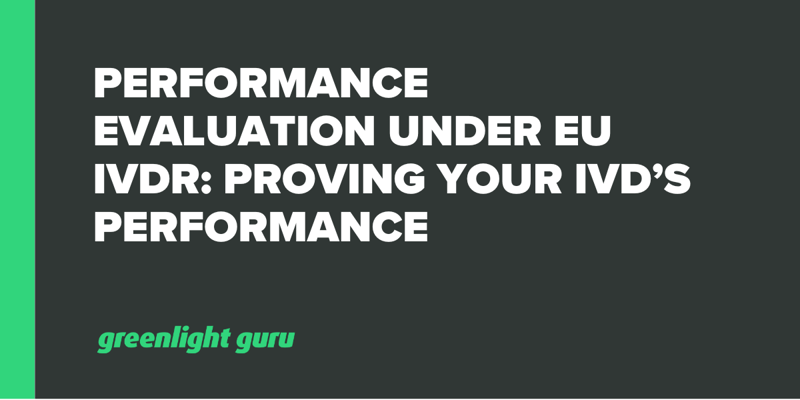Performance Evaluation Under EU IVDR: Proving Your IVD’s Performance

A Performance Evaluation (PE) is required for any in vitro diagnostic device (IVD) that a manufacturer wants to place on the EU market.
This requirement can be found in Article 56 of the new In Vitro Diagnostics Regulation (IVDR), and its goal is to demonstrate that the IVD in question achieves its intended purpose and is both safe and effective.
While IVDs may not have direct contact with a patient, like a medical device would, poor performance can still result in devastating consequences for patients. False positive or negative tests can cost patients time, money, and their health.
With that in mind, I want to walk you through what IVDR requires of manufacturers who are attempting to prove their device’s performance.
WANT TO BECOME A MEDICAL DEVICE INSIDER? Get VIP access to the best medical device content, checklists/templates & events delivered to your inbox every week by subscribing to our newsletter now!
What are the key components of a Performance Evaluation (PE)?
IVDR defines Performance Evaluation as “an assessment and analysis of data to establish or verify the scientific validity, the analytical and, where applicable, the clinical performance of a device.” The regulation goes on to state that PE is a continuous process that must be carried out throughout the life cycle of the device.
Scientific validity, analytical performance, and clinical performance are the three pillars of your PE and, in turn, you’ll need to prove each of them.
-
Scientific validity - IVDR defines scientific validity as “the association of an analyte with a clinical condition or physiological state.” For example, hemoglobin is correlated with anemia and other blood disorders. In this component of the PE, you will be expected to justify the use of any analytes, markers, or targets you use and establish their scientific validity via literature, clinical performance studies, or proof of concept studies.
-
Analytical performance - Analytical performance refers to how well your IVD measures or detects your analyte. To evaluate the analytical performance of your IVD, you’ll need to carry out bench studies like cross-reactivity, interference, and stability testing. The full list of characteristics you’ll need to measure can be found in Annex I, Section 9.1 of IVDR.
-
Clinical performance - IVDR defines clinical performance as “the ability of a device to yield results that are correlated with a particular clinical condition or a physiological or pathological process or state in accordance with the target population and intended user.” In other words, clinical performance is a measure of your device’s diagnostic accuracy. You’ll likely need to conduct a clinical performance study to prove this, though you may use literature as supporting evidence.
The results of all three of these items must be documented in individual reports. IVDR addresses scientific validity, analytical performance, and clinical performance in a comprehensive manner in Annex XIII, and I’d strongly encourage you to read through it carefully.
Pre-market Performance Evaluation (PE) requirements
The activities within the PE can be broken up into pre-market and post-market stages. The pre-market stage will consist of two main items: your Performance Evaluation Plan and your Performance Evaluation Report.
Performance Evaluation Plan (PEP)
The Performance Evaluation Plan lays out all the information you have about your device and the activities you plan on carrying out to prove its performance.
IVDR states that the Performance Evaluation Plan should include:
-
The intended purpose and characteristics of your device
-
The analyte or marker you’re using
-
Intended use, user, and indications for use
-
General Safety and Performance Requirements (GSPR) supported by your PE
-
The methods you’re using to examine the analytical and clinical performance of the device
-
An outline of your development phases, including the methods for determining the scientific validity and the analytical and clinical performance.
-
A description of the current State of the Art
-
Benefit-risk considerations
-
Your Post-market Performance Follow-up (PMPF) plan
Performance Evaluation Report (PER)
The PER is where all the clinical evidence—including your scientific validity report, analytical performance report, and clinical performance report—will be documented.
The Performance Evaluation Report must include:
-
Your justification for the approach you took to gather your clinical evidence
-
The literature search methodology, protocol, and report
-
The technology behind the device, its intended purpose, and any claims you’re making about its performance or safety
-
The nature and extent of the scientific validity and the analytical and clinical performance data you’ve evaluated
-
A comparison of the clinical evidence with the State of the Art
-
Any updates from your PMPF Evaluation Reports
Post-market Performance Evaluation (PE) requirements
IVDR also states clearly that “the clinical evidence and its assessment in the performance evaluation report shall be updated throughout the life cycle of the device.” In order to fulfill the post-market requirements, you’ll need to conduct a Post-market Performance Follow-up (PMPF).
The PMPF is meant to be a continuous collection of clinical data on the performance of your device after it has been placed on the market.
Like the initial Performance Evaluation, you’ll need to create a plan for your PMPF and document your outputs in a PMPF Evaluation Report. IVDR states that the plan should specify the methods and procedures you’ll use to proactively collect and evaluate scientific, performance, and safety data.
The goals of your PMPF should be to:
-
Confirm the safety and performance of the device throughout its expected lifetime
-
Identify previously unknown risks, limits to performance, or contra-indications
-
Identify and analyze any emergent risks
-
Ensure the continued acceptability of the benefit-risk profile
-
Identify any possible systemic misuse
If your IVD is Class C or D, your PMPF Evaluation Report will need to be updated annually. For lower risk devices, an annual update may not be necessary, but the schedule for updating it should be justified. Some low-risk devices without residual risk may not need a PMPF; however, the decision to forgo one must also be justified in the PE Evaluation Report.
Additionally, if your device is Class C or D, you’ll be required to issue a Periodic Safety Update Report (PSUR). The PSUR is another part of your post-market surveillance activities, and you are required to update it annually.
WANT TO BECOME A MEDICAL DEVICE INSIDER? Get VIP access to the best medical device content, checklists/templates & events delivered to your inbox every week by subscribing to our newsletter now!
Ensure every part of your Performance Evaluation is documented and linked with Greenlight Guru
With so many interconnected plans, reports, and studies, it’s essential that you have a QMS that allows you to maintain full traceability and helps you understand the relationships between elements of your QMS.
Greenlight Guru’s QMS software was built with this type of challenge in mind. Our software increases your visibility into your quality system by letting you truly see and interact with all of your documents in a single space. When you need to update a report, you can rest easy knowing that you have complete revision control and that everyone is working on the latest version of a document.
Get your free demo of Greenlight Guru today!
Looking for a design control solution to help you bring safer medical devices to market faster with less risk? Click here to take a quick tour of Greenlight Guru's Medical Device QMS software
Etienne Nichols is the Head of Industry Insights & Education at Greenlight Guru. As a Mechanical Engineer and Medical Device Guru, he specializes in simplifying complex ideas, teaching system integration, and connecting industry leaders. While hosting the Global Medical Device Podcast, Etienne has led over 200...










